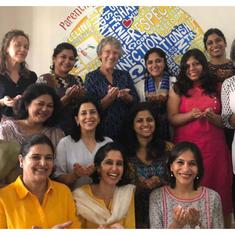While out to buy some haleem during the first week of Ramzan, I discovered that the popular Kolkata restaurant Saiqa had introduced a new dish: daleem. A red menu board on a tiled wall proudly advertised the dish, ensuring nobody missed it.
There is a lot to be said for Saiqa, a mostly working-class place, but I had never thought food innovation to be among its charms. Curious, I asked the person manning the counter about the culinary invention – only to be met with a googly. “It’s not a new thing – it’s haleem only,” said Mohammad Asghar Ali, the son of the proprietor. “Daleem is actually the correct name.”

Was daleem actually the right name? I had grown up eating the lentil-wheat-meat stew that was available only during Ramzan, the Islamic month of dawn-to-dusk fasting. I was pretty sure it had always been called haleem.
But as it turned out, Saiqa wasn’t an outlier. A number of Mughlai restaurants across Kolkata had made the nomenclatural switch, breaking away other restaurants that still stuck to a name of which I now suddenly felt possessive: haleem.
The question was why. Why were eateries across Kolkata – and other parts of South Asia – suddenly changing the name of this dish that crowns iftar spreads during Ramzan? As it happens, this almost trivial renaming is an indicator of just how radically social media is impacting religion and, in this case, Indian Muslims.
From Arabia to India
The origin of India’s haleem goes back to an ancient Arab dish: the hareesah. There are records of it being consumed in the Abbasid Caliphate in the 8th century. The dish was simple but laborious to prepare: it involved boiling shredded meat, cooking it again with ground wheat all night in a tannur (or tandoor) and then, grinding this mixture to a smooth paste. This dish is still consumed in West Asia, Iran and in Hyderabad’s Arab quarter, Barkas.
Once it reached India, the simple hareesah received some significant upgrades to suit desi palates. Spices were added, as also a variety of lentils (Saiqa claims it includes 13 different kinds). A new name was given to this dish: haleem, the Persian name for the bland wheat-and-meat hareesah.

Saiqa’s Asghar Ali was clear on why daleem was the correct name for the dish: “Dal se banta hai, isliye daleem.” It’s made with dal (lentils), hence daleem.
But the real reason had less to do with alliteration and more to do with the almighty. “Haleem is a name for Allah,” explained Shamsher Alam of Zam Zam, another Mughlai restaurant in Kolkata that now goes with daleem. “It seemed wrong to name a food item that uses a name for Allah, so last year I changed it.”
How did Alam realise this evident fact after happily selling haleem for two decades? As with so much else in these fractious times, the culprit was social media. “Nowadays, mashallah, we have a lot of information on WhatsApp and on the internet,” said Alam. “Someone saw it there and told me. That’s when I realised I should change the name.”
Going viral
Alam wasn’t alone. Debates around whether it’s right to name a stew after an attribute of God have raged across South Asia. In 2017, The Times of India reported on this tussle among the Muslims of Hyderabad, the world capital of haleem. Much the same discussion is happening in Pakistan and Bangladesh, too.
Not everyone in the subcontinent supports the rechristening. One Pakistani user on Twitter brusquely called it a “postmodern renaming attempt by mullah clowns”. A Bangladeshi food blogger argued that it is clear that when she uses haleem for the name of a dish, she is not referring to the attributes of God. “Allah knows what is in my heart. I don’t intend to please a few important people,” she wrote on her Facebook page, showing the incredible power of social media in engendering conflict even on a thing as universally loved as haleem.
It's not #daleem, never was. Always been #Haleem, derived from hareesa, is a Persian word. Postmodern renaming attempt by mullah clowns pic.twitter.com/GOQMlQpyUN
— Dan Qayyum (@DanQayyum) September 30, 2017
Kolkata’s biggest Mughlai restaurant chain Arsalan has also resisted calls to change the name. “Wakeel [the Urdu word for lawyer] is also one name for Allah. Will people stop using that too?” asked Mohammad Ghulam Mustafa, a member of the family that owns Arsalan. “People who don’t read the namaaz, read a few messages on WhatsApp and start to think they are an alim [Islamic scholar]. That is the problem.”
I am not allowed to call this Haleem in our household, we call it Daleem. But like Shakespeare said "A rose by any other name....” pic.twitter.com/mJJ6wf2tco
— shah G (@n98gillani) May 30, 2019
Social media faith
Mustafa’s snarky dismissal of “WhatsApp alims” is the most interesting insight to arise from what is at best a quirky change of name. Social media has given – for better or worse – the average Muslim more of a say in his religion, a role that was earlier performed by religious scholars.
Quite a bit of social science research has noted the impact of social media on faith and its role in weakening religious gatekeepers. American sociologist Paul McClure argues that the internet encourages “religious tinkering” and “religious participation as free agents”. Adding to that, Heidi Campbell, an American scholar of religion, notes how social media allows people to constantly reinvent their religious identities:
“It used to be that a religious identity was something you took on through maybe religious education or confirmation or baptism. You kind of put it on like a cloak. But now people see identity as something that you can negotiate, that you construct and you perform. So individuals especially use the Internet and other resources to seek out their own ‘spiritual tribe’ online – a group of people where they can make sense of their religious self and their religious belief. Facebook and Twitter, blogs, social media allow people to express their religious identity, to experiment and to create a cohesive identity that’s free from institutional constraints.”
Predating Mustafa’s “WhatsApp alim” quip, a 2011 article in The Guardian says: “Individuals now have a much more autonomous role in deciding whom to approach as a source. Those people may have official, traditional credentials or they may be Rabbi Google.”

While the greatest impact of social media is on Christianity, given the deep penetration of the internet in the West, its effects are spreading to Muslims and how they practise their faith. Mohammed Ibahrine of the American University in Sharjah writes on the London School of Economics’ Middle East Centre blog:
“For centuries, interpretations of the Quran were kept a reserved domain for a small minority of ulama (the plural of alim). Social networking websites have become avenues for disseminating sacred interpretations, sometimes undermining traditional religious authorities. The blossoming of digital fatwas is also an indication of the splintering of orthodoxies and the emergence of heresies. Consequently, religious authority has become a contested domain, rather than an accepted reality by the uneducated masses.”
Modern conservatism
While this undermining of the traditional ulama is democratic, it might also, paradoxically, lead to conservative outcomes. In Indonesia, for example, social media is encouraging irreligious millennials to become born-again, ultra-orthodox Muslims as part of a movement known as hijrah.
While there has been no such stark change in India, clearly even here, social media is allowing people to fashion their own understanding of Islam, free of traditional social structures. One outcome of this is an attempt to follow a so-called purer form of Islam in which even a detail as trivial as the name of a stew – unnoticed for centuries – is “corrected” by social media didacticians.
Also read:
Why are Indian Muslims using the Arabic word ‘Ramadan’ instead of the traditional ‘Ramzan’?










